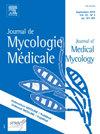2岁儿童脑室内霉菌感染提示曲霉病,临床结果成功
IF 1.8
4区 医学
Q3 MYCOLOGY
引用次数: 0
摘要
小儿孤立性中枢神经系统(CNS)霉菌感染并不常见,但如果不及时诊断和治疗,可能会致命。这种侵袭性病变通常表现为实质部位的脓肿。虽然较新的唑类抗真菌药物已显示出改善的结果,但儿科年龄组的治疗数据有限,特别是在幼儿中。我们报告一个非常年轻的孩子一个不寻常的霉菌感染的位置,在侧脑室的颞角,成功地管理。2岁男童既往感染COVID-19,无其他明显免疫功能障碍,表现为颅内压升高。CT/MRI示左侧颞角囊性病变。在最初对囊肿内容物进行非诊断性抽吸后,患儿接受了病变切除手术。内容物氢氧化钾染色显示菌丝呈透明分隔,但真菌培养无菌。标本的组织病理学高度提示曲霉病。患儿接受伏立康唑充分治疗,随访22个月临床结果良好。很少,中枢神经系统霉菌感染可表现为儿童脑室内占位性病变。这种差别必须牢记在心。在我们的病例中,感染可能是COVID-19的后遗症。该病例还强调了早期和积极的伏立康唑治疗儿童颅内霉菌感染(很可能是曲霉病)的成功临床结果的潜力。本文章由计算机程序翻译,如有差异,请以英文原文为准。
Intraventricular mould infection suggestive of Aspergillosis in a 2-year-old child with successful clinical outcomes
Pediatric isolated central nervous system (CNS) mould infections are uncommon but potentially fatal if not promptly diagnosed and treated. Such invasive lesions usually present as abscesses in parenchymal locations. Although the newer azole antifungals have shown improved outcomes, treatment data are limited in the pediatric age group, especially in young children. We report a case of a very young child with an unusual location of mould infection, in the temporal horn of the lateral ventricle, managed successfully. The 2-year-old-male child with prior COVID-19 infection and no other apparent immune dysfunction presented with features of raised intracranial pressure. CT/MRI imaging demonstrated a left temporal horn cystic lesion. Following an initial non-diagnostic aspiration of the cyst contents, the child underwent excision of the lesion. The potassium hydroxide stain of the content revealed hyaline septate hyphae, but the fungal culture was sterile. Histopathology of the specimen was highly suggestive of aspergillosis. The child was adequately treated with voriconazole, and had excellent clinical outcome at 22-month follow up. Rarely, CNS mould infection can manifest as an intraventricular space occupying lesion in children. Such a differential must be borne in mind. In our case, the infection was possibly a COVID-19 sequelae. The case also highlights the potential for successful clinical outcomes with an early and aggressive voriconazole treatment in pediatric intracranial mould infections, most likely aspergillosis.
求助全文
通过发布文献求助,成功后即可免费获取论文全文。
去求助
来源期刊
CiteScore
5.10
自引率
2.80%
发文量
68
审稿时长
6-12 weeks
期刊介绍:
The Journal de Mycologie Medicale / Journal of Medical Mycology (JMM) publishes in English works dealing with human and animal mycology. The subjects treated are focused in particular on clinical, diagnostic, epidemiological, immunological, medical, pathological, preventive or therapeutic aspects of mycoses. Also covered are basic aspects linked primarily with morphology (electronic and photonic microscopy), physiology, biochemistry, cellular and molecular biology, immunochemistry, genetics, taxonomy or phylogeny of pathogenic or opportunistic fungi and actinomycetes in humans or animals. Studies of natural products showing inhibitory activity against pathogenic fungi cannot be considered without chemical characterization and identification of the compounds responsible for the inhibitory activity.
JMM publishes (guest) editorials, original articles, reviews (and minireviews), case reports, technical notes, letters to the editor and information. Only clinical cases with real originality (new species, new clinical present action, new geographical localization, etc.), and fully documented (identification methods, results, etc.), will be considered.
Under no circumstances does the journal guarantee publication before the editorial board makes its final decision.
The journal is indexed in the main international databases and is accessible worldwide through the ScienceDirect and ClinicalKey platforms.

 求助内容:
求助内容: 应助结果提醒方式:
应助结果提醒方式:


